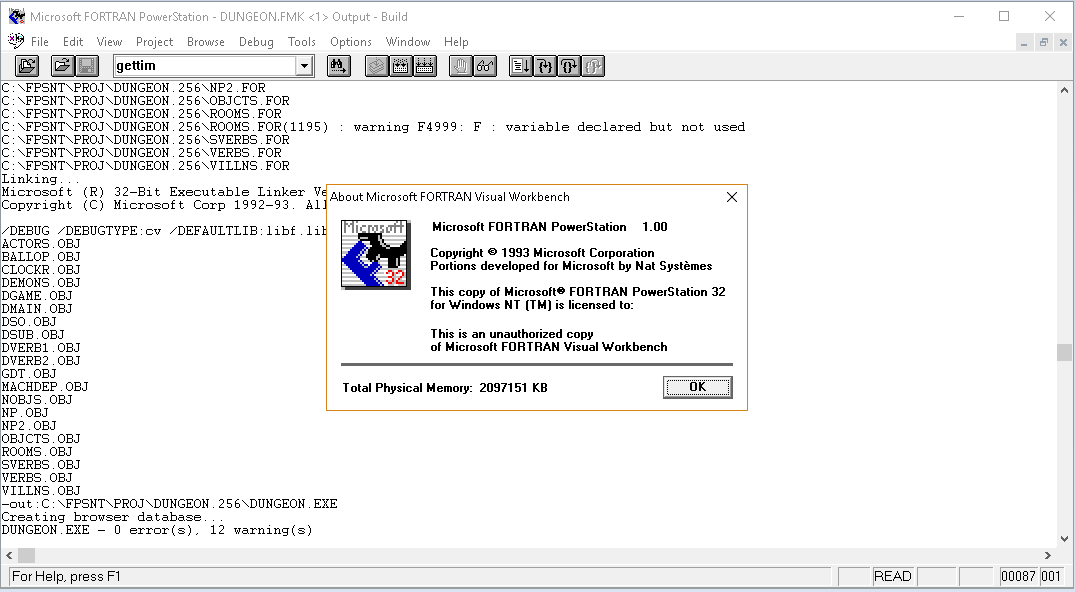
Fortran Powerstation 40 Manual
We only have Windows XP w/ SP2 CDs and we used the download of SP3 for the update. The problem we are having now is, we updated our XP - Sp2 to Service Pack 3. Add arabic language to windows xp sp3. Now when we go to add the Languages it asks for Windows XP with SP 3 CD.
Significantly, the increasing popularity of FORTRAN spurred competing computer manufacturers to provide FORTRAN compilers for their machines, so that by 1963 over 40 FORTRAN compilers existed. For these reasons, FORTRAN is considered to be the first widely used programming language supported across a variety of computer architectures. Microsoft Fortran PowerStation 4.0. Microsoft Corp stopped developing, supporting and selling their FORTRAN Powerstation compiler some time ago. And debugging of Fortran subroutines for TRNSYS. Contact your TRNSYS distributor or go to the TRNSYS tutorials section of this website to download a modified version of the file exec.for.
Microsoft Fortran PowerStation 4.0 Microsoft Fortran PowerStation 4.0 Microsoft Corp stopped developing, supporting and selling their FORTRAN Powerstation compiler some time ago. It was still possible with TRNSYS 14.2 to use the Powerstation compiler to recreate the 32-bit trnlib.dll file needed to run TRNSYS. Unfortunately, the Powerstation compiler does not accept many of the TRNSYS features standard in version 15. It is highly recommended that you switch to. By excluding some of the standard TRNSYS 15 features, it is still possible to use the Powerstation 4.0 compiler. Below is a list of features that you will lose in doing so.
• Type56 (multizone building) • Type61 (communication with non-fortran DLLs) • Type66 (communication with Engineering Equation Solver routines) • Communication with external programs Setting up the Powerstation Project Follow these instructions to get started using the MSFPS40 Developer Studio for handling the compiling, linking, and debugging of Fortran subroutines for TRNSYS. Contact your TRNSYS distributor or go to the of this website to download a modified version of the file exec.for. Move the standard file trnsys15 kernal exec.for to a safe location. Move the exec.for file that you downloaded with this document into trnsys15 kernal 3. Start the MSFPS40 Developer Studio.
Under the File menu, create a new Project Workspace. From the list of 'Types of Projects' select Dynamic Link Library. Give the project a name. For example, you might name the project 32trnsys and place it in the c: 32trnsys directory. Under the Insert menu, click Add Files to Project. Add all of the Fortran files (.for) from the Kernal and Types subdirectories in the /trnsys15 directory. Add the file dumf40.lib from the dummy subdirectory.
Add your own custom components, if necessary. You now need to remove a few files from the project. These are userlib.for, callprogram.f90, Type61.for and Type66.for. You also need to remove the call to userlib from trnsys.for.
Open the file trnsys.for and search for 'CALL USERLIB'. There should be 2 instances. Under the Build menu, click Settings.
You will notice that there are numerous settings here controlled by a series of tabs. Below are the important settings for each of these tabs. Each tab can have several submenus, so there are many settings involved. Only the settings that must be changed from default values are described below. First, there should be two items in the left box called (in this example): 32TRN - Win32 Debug and 32TRN - Win32 Release. Be sure you have the Debug version selected. Debug Tab General Executable for session: c: trnsys15 trnsys.exe Working Directory: c: trnsys15 Program Arguments: c: 32trnsys error.txt Additional DLLs Fortran Tab Fortran Language Local Name: c: trnsys15 trnlib.dll (note: if you select both items in the left 'Settings for:' box, you cannot alter this category.

You must select only the Debug project. Click box by Extended Bounds and Error Checking Link Tab General Output File: c: trnsys15 trnlib.dll Object/library modules: blank Check box 'Generate debug info.' Customize Output filename should now read c: trnsys15 trnlib.dll 8. In this step, the current trnlib.dll file will be overwritten! It is wise to back it up somewhere on your computer before proceeding!
Under the Build menu, click Rebuild All. Watch the bottom window for errors and problems with compiling and creating the trnlib.dll output file. If everything worked correctly, the TRNSYS DLL was created in the trnsys15 directory and TRNSYS can be run with the updated DLL.
To run TRNSYS, select Execute from the Build menu. TRNSYS will prompt you for a TRNSYS input file. To use the debugging features of MSFPS40, select Debug from the Build menu, then Go. At this point, the program will state, 'TRNSYS.EXE does not have any debug information. Click OK because we are concerned with the Fortran DLL and not the TRNSYS executable. Without a breakpoint or a bug, TRNSYS will just start and run until the simulation is finished.